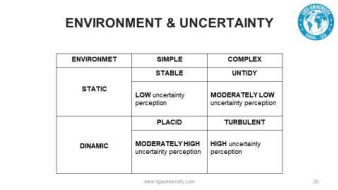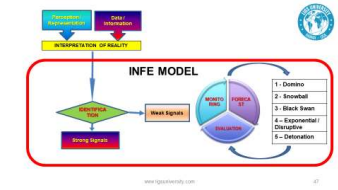Soft (Weak) Signals In The Strategy Of Planning Business Environments | Dr. Roberto Alejandro Llauró
Did you miss our latest webinar by Dr. Roberto Alejandro Llauró? Here's his summary on the subject. Enjoy the read!
1.
1.a) WHAT IS BEING WELL INFORMED?
It is not to have a significant amount of information. It is having access to pertinent, interesting, useful and selected information. It requires a predisposition to pro-action, attention and monitoring of external environments, seeking to listen and know the market, anticipate movements, observe needs and expectations (declared or implicit) of the environment. It is not oriented to quantity, but on attention, speed, selectivity and quality in the information.
STRATEGIC INTELLIGENCE: it is not enough for information to be interesting, up-to-date, but in some way organized, accessible and mainly bears anticipatory meaning. It privileges the idea of anticipating and detecting changes or possible discontinuities (ruptures, radical changes) that may occur in the relevant environment of the organization. SI enhances the timeliness of the organization’s response in three ways: DETECTS surprising changes in real time as they become evident, RESPONDS in real time without waiting for the annual planning exercise, USES a cross-organizational task force approach which expedites the resolution of issues.
(1.b) STRUCTURE OF THE CONCEPTUAL FRAMEWORK
RATIONAL THINKING more developed in the West. It focuses on the material aspects of life since our mental power has been focused on the control and use of material things, the improvement of physical comforts and the acquisition and accumulation of possessions.
INTUITIVE THINKING more developed in the East, where spiritual realities are maintained more uniformly and our mental power has been used in concentration and meditation and in philosophical and metaphysical knowledge.
NEED FOR BALANCE We are becoming aware of the need to balance both types of knowledge in order to reach more balanced solutions as a way to better face the challenges of life, for mutual benefit.
(1.c) THINKING MODELS
TRADITIONAL THOUGHT forces the situations of reality to adapt them to pre-prepared rigid schemes. STRATEGIC THINKING seeks to understand and interpret the environment or scenario where you must develop your activity to adapt and take advantage of the best combination of existing resources, experimenting with new innovative ideas. Strategic and creative managers would have little difficulty with this concept because, they have essentially a 'WEAK SIGNAL MENTALITY'
(1.d) DEVELOPING OF A STRATEGIC MINDSET
It is A PROCESS that occurs in the mind of the executive that allows him to visualize what the organization will be like in the future. It is A SKILL that must be developed by all members of the organization, in order to be considered key elements. It is about PRIORITIZING each of the components that make up a situation (strong and weak signals), to enhance the reasoning abilities of each individual and achieve restructuring of processes seeking corporate or group success.
2.
(2.a) BUSINESS ENVIRONMENT ANALYSIS
Businesses and companies are inserted in an environment with which they necessarily interact. Due to changes in this business environment, organizations must develop a constant ability to adapt. To do this, they must be attentive to external movements (local, regional, national and international) that can potentially suggest future events in areas such as technology, social, behavioral, legal, relational, etc.

This process is necessary to be able to make decisions in the environment of uncertainty imposed by such environmental factors.. All this depends on the degree of perception and interpretation (models and conceptual schemes) that directors and managers develop about these conditions, which will allow them to understand it and be able to put into practice solutions to certain problems that the organization faces.
We can define: (a) GENERAL ENVIRONMENT: it is common to all companies, and is made up of factors not controllable by them. (IMPE + PEST) and (b) SPECIFIC ENVIRONMENT: constituted by a series of factors that only affect the companies or businesses of the specific sector under analysis. (SWOT + PORTER)
(2.b) ENVIRONMENT & UNCERTAINTY
Organizations are only able to recognize their environment through the perception process of those who run them.
SUBJECTIVE VISION The organization can only interpret the environment through its directors and managers.
MODELS AND CONCEPTUAL SCHEMES of directors and managers arise from an abbreviated, generalized and correctable ordering of their different experiences within the psyche and serve as a frame of reference for action, transformed into maps and cognitive biases.
This process of perceiving the environment occurs following three phases: Scanning monitoring, searching and obtaining data to identify key trends, changes and environmental events that could affect the operation and performance of the company. Interpreting indicates when new constructs are introduced in the collective cognitive maps of the organization and perceptions are shared among its members. The threats and opportunities of the environment are identified. Learning implies a new response or action based on the interpretation phase or the acquisition of new data and development of new knowledge or experiences. It can be affected by the personal beliefs, training, culture, and perceptions of managers and directors, as well as the organization's objectives, goals, and policies.
(2.c) COMPLEXITY AND DYNAMISM
COMPLEX and DYNAMIC environments are those with the highest degree of uncertainty. Companies that depend on many volatile external variables have to face an environment with great uncertainty.
COMPLEXITY It is defined by the number of relevant external variables that have a significant impact on your company. In complex environments the organization requires a large amount of sophisticated knowledge about the products, customers, suppliers, and other components of that environment.
DYNAMISM It is the speed with which these variables change. It is determined by a variety of factors, such as: unstable governments, unforeseen changes in the economy, variations in customer demands, rapidly changing technology or knowledge base, etc.

(2.d) WHEN TO ANALYZE THE ENVIRONMENT?
If we work in a STABLE environment, planning will be simple and similar to the previous year. If we work in PLACID or UNTIDY environments the level of complexity increases, but the benefits of good strategic planning also increase. If we operate in a TURBULENT environment, long-term planning is more difficult, since it is almost impossible to anticipate changes in the environment.
(2.e) HOW TO ANALYZE THE ENVIRONMENT?
Ad-hoc analysis short-term, sporadic reviews, usually triggered by a crisis. Regular analysis surveys carried out on a regular schedule (for example, once a year). Continuous analysis continuously structured data collection on a broad spectrum of environmental factors
(2.f) HOW TO OBTAIN RELEVANT INFORMATION
3FORMAL METHODS analyze the data with the rigor of a scientific methodology. They are easily transmitted and can be learned and give objective results.
NON-FORMAL METHODS analyze data from multiple sources applying mental processes in which a large number of relationships between variables are established. They are learned and perfected through the experience of the subject and form part of his know-how. They are difficult to transfer in their entirety and give subjective results.
3.
(3.a) SIGNALS
In the turbulent context in which we operate business, it is not enough to apply conventional environmental analysis techniques since they are fed from and with exclusive data from the past or the present, so we must use environmental signals.
Environmental signals are like footprints. In other words, any identified signal can show us a specific behavior, but with infinite possible outcomes.
Any probabilistic statistical elaboration of the possible behaviors of the identified signals will be more applicable if the underlying reality does not change (1) too much, (2) too fast, or (3) for a long time.
As an example, the COVID pandemic was an early signal (as we will develop in a future event), where, applying the methodology as described here, we were able to anticipate the high probability of occurrence of a pandemic of these characteristics, although not its specific moment. What we could not anticipate were: (a) the way that international organizations (WHO, UN, etc.) and the governments of the different countries reacted to this inconvenience, nor (b) the political, economic, social and cultural consequences that these measures are causing on the different populations in the world.
In any case, we must always apply a three-step identification routine:
(1) Identify the signal
(2) Imagine/assume their possible future behaviors.
(3) Where possible we should use known (learned) models of learning to empower our imagination to be able to perform this type of environmental analysis.
(3.b) IGOR ANSOFF & WEAK SIGNALS
Anshoff jumped from identifying difficulties to proposing solutions, suggesting concepts and tools to deal with the specific problem of turbulence. For Ansoff any change taking place is preceded by some form of ‘‘WARNING’’ (footprint?), which the analyst has the role of capturing and making good use of. This is what he called a SIGNAL, based on the information. Anshoff described the future as uncertain, but anticipable.
Based on the theory work of Shannon and Weaver (1940) Anshoff distinguished between: WEAK SIGNALS features of incipient changes that can help managers avoid strategic surprises. They are imprecise early indications about impending impactful events and STRONG SIGNALS enough visible and concrete,
Weak signals are, basically, early indicators of about coming events, early indicators of, “symptoms” of, or “a soft form of information about coming events’’. Is a tentative relationship between phenomena that claim attention and the impact of such phenomena on the survival of the firm. Weak signals might appear in the strategic environment of the firm characterized in terms of ‘‘earliness’’, intensity and criticality. Turbulence induce some worries, possibly involving difficult-to-predict, even surprising, and, frequently difficult-to-cope with developments.
To move from an imprecise perception (weak signal) to a more substantial and usable indication (strong signal), Ansoff developed the idea of an applying different and successive filters. A filter lets some signals through and keeps out (filters) others. For Anshoff such a reworked filtering system could then allow for the seamless integration of weak signals into strong ones, enhancing the learning curve and strategic responsiveness of the firm.
(3.c) DISCOVERING WEAK SIGNALS
Traditionally, the search for weak signals has been expert evaluation with cognitive combination of information from multiple sources. Recent research has suggested that there are predictable patterns in how new technologies and innovations are popularized and how the writing about new technologies proceeds after inventions have been made. For example, the development of CPS navigation system has led to revolutionary changes in other areas of activities.
Detection (Identification) of weak signals requires sensitivity as well as expertise on the part of the observers.
Generally speaking weak signals can be identified by sociopolitical, economic, and technological experts who are outside the firm, advisory groups which provide weak signal inputs on a systematic basis, individuals (both managers and workers) who serve in the interface functions such as marketing, purchasing, legal, public relations, or R&D and/or other sources of internal weak signals such as individuals who have broad contacts inside the firm: personnel and management developers, organizational and strategic planners, etc.
(3.d) INFE MODEL
The main purpose of this conference was to point out the growing importance of the use of weak signals in the planning of business scenarios and the presentation of the IMFE model (Identification, Monitoring, Forecasting and Evaluation) as a useful method to be used especially by SMEs as a valid, simple and accessible resource.

(3.e) BLACK SWAN EVENTS
BLACK SWAN events are unpredictable in nature and are often large and devastating. Given their unpredictability, it is practically impossible to develop specific policies to prevent black swans per se. That said, ex-post assistance to alleviate the damage and minimize, as far as possible, human and economic losses are of paramount importance. (Examples: USA Elections 2016 and BREXIT).